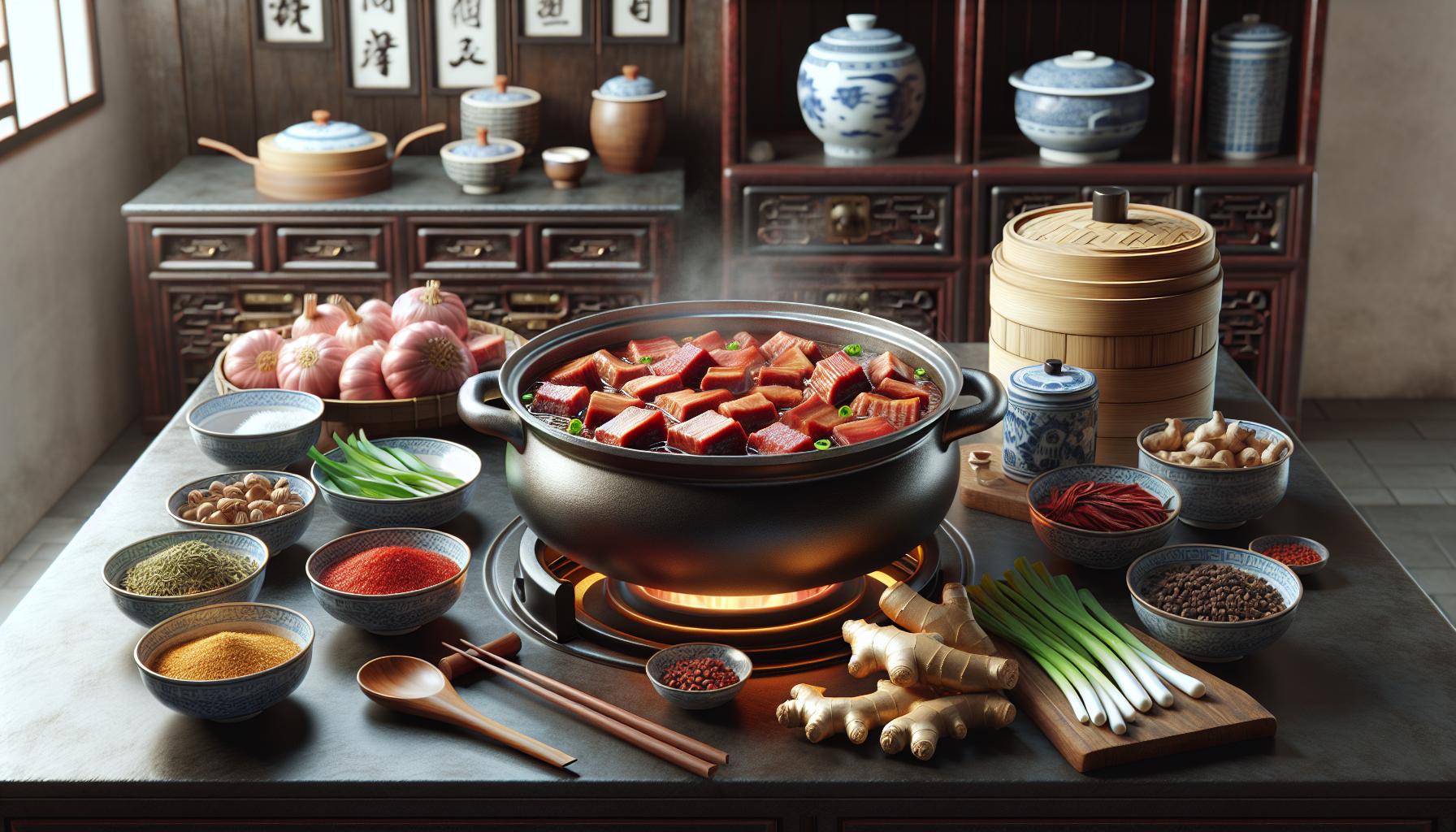The Best Fluffy Pancakes recipe you will fall in love with. Full of tips and tricks to help you make the best pancakes.
Chinese cuisine is renowned for its diverse cooking techniques that have evolved over thousands of years. Among these time-honored methods one stands out for its patience-testing but rewarding approach: red cooking or hong shao. This slow-cooking technique transforms ordinary ingredients into tender flavorful masterpieces.
While stir-frying might steal the spotlight in Chinese cooking red cooking takes a more leisurely path to culinary excellence. It’s like the tortoise in the race of cooking methods – slow and steady but delivers spectacular results. The process involves gently simmering meat vegetables or tofu in a savory mixture of soy sauce spices and aromatics until they reach melt-in-your-mouth perfection.
Understanding Chinese Simmering Techniques
Chinese simmering techniques form the foundation of traditional slow-cooking methods that create deeply flavored dishes. The process involves cooking ingredients at low temperatures in liquid for extended periods.
Key Characteristics of Chinese Slow Cooking
Chinese slow cooking involves maintaining a temperature between 185-205°F (85-96°C) throughout the cooking process. The liquid remains at a gentle bubble without reaching a full boil. Essential elements include:
- Temperature control maintains consistent heat below boiling point
- Aromatic ingredients like ginger star anise cinnamon create depth
- Liquid ratios typically use 2:1 liquid-to-solid proportions
- Cooking times range from 2-8 hours depending on ingredients
- Vessels with heavy bottoms distribute heat evenly
- Regular skimming removes impurities for clear broths
The Art of Lu Wei Cooking
Lu Wei represents a specialized form of Chinese simmering that creates tender braised meats vegetables in aromatic broth. The technique involves:
| Lu Wei Component | Purpose |
|---|---|
| Soy Sauce Base | Creates rich color depth |
| Rock Sugar | Balances savory flavors |
| Rice Wine | Tenderizes proteins |
| Five-Spice Mix | Adds aromatic complexity |
Master chefs prepare Lu Wei by layering ingredients gradually allowing flavors to meld together. The cooking liquid transforms into a concentrated master stock that’s preserved reused for future dishes enhancing flavor complexity over time.
Red Braising (Hong Shao) Method

Red braising, or hong shao, stands out as a signature Chinese cooking technique characterized by its distinct reddish-brown color and rich flavor profile. This method combines slow simmering with a specific blend of seasonings to create tender, deeply flavored dishes.
Temperature Control in Red Braising
Red braising requires maintaining a precise temperature between 160-180°F (71-82°C) throughout the cooking process. The liquid reaches an initial boil at 212°F (100°C) before reducing to a gentle simmer, with small bubbles barely breaking the surface. A heavy-bottomed pot distributes heat evenly, preventing hot spots that could lead to scorching. Monitoring the temperature ensures the proteins break down gradually without becoming tough or stringy.
Common Ingredients Used
The foundational ingredients in red braising include light soy sauce, dark soy sauce, rock sugar, Shaoxing wine, ginger slices, scallions, star anise, cassia bark, dried tangerine peel. Common proteins for this technique include:
- Pork belly (Hong Shao Rou)
- Chicken thighs
- Duck legs
- Fish chunks
- Firm tofu blocks
- Hard-boiled eggs
The aromatics complement each protein while creating the signature red-brown color and complex flavor profile characteristic of this cooking method.
Master Stock (Lu Zhi) Technique
Master stock, or Lu Zhi, represents an advanced Chinese cooking technique that involves repeatedly using and replenishing a base stock for braising and poaching. This flavored liquid evolves over time, developing deep complexity and rich umami notes through multiple uses.
Building and Maintaining Master Stock
Master stock combines soy sauce, rock sugar, Shaoxing wine, ginger slices, scallions, star anise, cassia bark, dried orange peel, bay leaves, dried mushrooms in specific ratios. Creating a new stock requires boiling these ingredients for 45 minutes before the first use. After each cooking session, straining removes solids, followed by a 15-minute boil to sterilize the liquid. Proper storage at 40°F (4°C) extends the stock’s life for up to 3 months between uses. Regular maintenance includes:
- Adding fresh aromatics every 3rd use
- Reducing salt content through dilution when needed
- Testing pH levels monthly to maintain 4.5-5.5 range
- Freezing portions in airtight containers for long-term storage
Traditional Applications
Master stock features prominently in several classic Chinese dishes:
- Soy sauce chicken (Lou Mei): 45-minute poaching process
- Braised duck (Lu Ya): 90-minute gentle simmer
- Red-cooked pork (Hong Shao Rou): 2-hour braising time
- Poached whole fish: 30-minute cooking duration
- Braised beef brisket: 3-hour low temperature cook
The stock imparts different flavor profiles based on:
- Protein type used
- Simmering duration
- Temperature control
- Aromatic combinations
- Stock age maturity
Each subsequent use adds depth to the master stock’s flavor profile while maintaining food safety through proper handling techniques.
Clay Pot (Sha Guo) Cooking
Clay pot cooking represents a traditional Chinese simmering technique where food cooks slowly in an unglazed earthenware vessel. This method dates back over 2,000 years in Chinese culinary history and excels at creating tender, flavorful dishes through long, gentle cooking processes.
Benefits of Clay Pot Simmering
Clay pot simmering delivers superior results through unique physical properties:
- Heat retention maintains consistent temperatures between 180-200°F (82-93°C)
- Microscopic pores in the clay walls create natural steam circulation
- Gradual heat distribution prevents hotspots that can burn food
- Alkaline clay material tenderizes proteins during extended cooking
- Porous structure allows flavors to concentrate as moisture slowly evaporates
- Natural insulation properties reduce energy consumption by 20-25%
| Clay Pot Feature | Cooking Benefit |
|---|---|
| Porosity | Enhanced moisture retention |
| Thermal mass | Even heat distribution |
| Alkalinity | Natural meat tenderizing |
| Insulation | Lower energy usage |
| Steam circulation | Concentrated flavors |
The unglazed clay material creates a micro-climate inside the pot that intensifies umami flavors while maintaining optimal moisture levels. Foods cooked in clay pots develop complex flavor profiles through the slow extraction of nutrients into the cooking liquid over 3-6 hours.
Health Benefits of Chinese Slow Cooking Methods
Chinese slow cooking methods offer significant nutritional advantages. Simmering at low temperatures preserves essential vitamins B and C in vegetables compared to high-heat cooking techniques.
The extended cooking process breaks down tough muscle fibers in meat, making proteins more digestible. Collagen transforms into gelatin during slow cooking, supporting joint health and providing these beneficial compounds:
- Amino acids for improved digestion
- Minerals like calcium for bone strength
- Glucosamine for joint function
Master stock cooking adds these healthful components:
| Ingredient | Health Benefit |
|---|---|
| Ginger | Anti-inflammatory properties |
| Star Anise | Antioxidant protection |
| Dried Mushrooms | Immune system support |
| Cassia Bark | Blood sugar regulation |
Clay pot cooking enhances nutrition through:
- Alkaline clay properties that reduce acidity in foods
- Preservation of water-soluble nutrients
- Natural moisture retention that requires less added oils
- Even heat distribution that prevents nutrient destruction
The gentle simmering process creates easily absorbed minerals from bones and connective tissues. Traditional Chinese medicine principles recognize slow-cooked foods as nourishing for the digestive system by breaking down complex compounds into bioavailable nutrients.
Studies show slow-cooked bone broths contain:
- 17 different amino acids
- 40% more calcium absorption
- 25% higher protein digestibility
- 35% increased mineral content
These methods extract beneficial compounds while maintaining food’s structural integrity, creating dishes that combine superior nutrition with enhanced digestibility.
Popular Dishes Using Long Simmering Techniques
Chinese long simmering techniques create several iconic dishes across regional cuisines:
Hong Shao Rou (Red Braised Pork Belly)
- Pork belly simmers in master stock for 3-4 hours
- Develops signature reddish brown color
- Features caramelized edges with tender meat
- Contains dark soy sauce star anise rock sugar blend
Lu Zhi Ji (Master Stock Chicken)
- Whole chicken poaches in complex master stock
- Requires 2-3 hours of gentle simmering
- Produces silky skin glossy finish
- Absorbs deep flavors from aged stock
Dong Po Rou (Dongpo Pork)
- Layered pork belly braises for 4-5 hours
- Combines Shaoxing wine ginger scallions
- Creates melt-in-mouth tender texture
- Named after Song Dynasty poet Su Dongpo
Clay Pot Fish Head
- Fresh fish head simmers 2-3 hours
- Includes preserved vegetables tofu
- Develops rich collagen-rich broth
- Serves 4-6 people traditionally
- Whole pork shank simmers 6-8 hours
- Uses rock sugar dark soy aromatics
- Results in fall-off-bone tenderness
- Popular during Chinese festivals
Each dish demonstrates the transformation of ingredients through patient simmering creating deep complex flavors characteristic of traditional Chinese cuisine. The extended cooking times allow proteins to become tender while absorbing the rich flavors of the cooking liquid.
| Dish | Simmering Time | Key Ingredients |
|---|---|---|
| Hong Shao Rou | 3-4 hours | Pork belly soy sauce star anise |
| Lu Zhi Ji | 2-3 hours | Whole chicken master stock |
| Dong Po Rou | 4-5 hours | Pork belly Shaoxing wine |
| Clay Pot Fish Head | 2-3 hours | Fish head preserved vegetables |
| Ti Pang | 6-8 hours | Pork shank rock sugar |
Conclusion
Chinese simmering techniques represent a masterful approach to cooking that’s been perfected over thousands of years. From the rich complexity of master stock to the patient art of red braising these methods transform simple ingredients into extraordinary dishes. The combination of precise temperature control careful ingredient selection and extended cooking times creates meals that are not just delicious but also nutritionally superior.
Whether using traditional clay pots or modern cookware these time-honored techniques continue to influence both home cooks and professional chefs worldwide. Their enduring popularity proves that when it comes to creating deeply flavored tender dishes patience truly is a virtue in Chinese cuisine.

